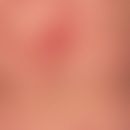DefinitionThis section has been translated automatically.
Antibody-induced blockade of the most important checkpoints CTLA-4 and PD-1/PDL-1 is now a key therapeutic principle in numerous different tumor entities (melanoma, squamous cell carcinoma, Merkel cell carcinoma and non-dermatological bronchial, breast, kidney, liver, urinary bladder and head and neck tumors). A large number of checkpoints are known. The spectrum of adverse effects is considerable.
Cutaneous irAEs are the most common side effects of these therapies. They occur in up to 34% of patients treated with PD-1 inhibitors and in 43% to 45% of patients treated with CTLA-4 inhibitors (Muntyanu A et al. 2021). On the one hand, the side effects result from an immune response against normal tissue, whereby any organ can be affected. On the other hand, pre-existing cutaneous inflammatory diseases (e.g. lichen planus, psoriasis, sarcoidosis) can be activated or reactivated. As the autoreactive T-cell clones underlying irAEs are likely to persist long after treatment has ended, it is possible that irAEs may occur for a long time, possibly many years after treatment.
ClassificationThis section has been translated automatically.
The cutaneous IrAEs in detail:
Exanthematic clinical pictures
- Lichenoid exanthema
- Classical lichen planus (Boyle MM et al.2022)
- Lichen (ruber) planus pemphigoides (Boyle MM et al.2022)
- Maculopapular and morbilliform exanthema
- Psoriasis (Troyanova-Slavkova S et al. 2018; Guven D et al. (2020)
- Neutrophilic dermatoses:
- Sweet syndrome (Ravi Vet al. 2019)
- Pyoderma gangraenosum (Ravi Vet al. 2019)
- Psoriasis pustulosa palmaris et plantaris (Furuta H et al. 2021)
- Pustular nail psoriasis (Di Altobrando A et al. 2020)
- Hidradenitis suppurativa (Maillard A et al. 2021)
- Multiforme exanthema
- Erythema (exudativum) multiforme (Kadoi R et al. 2024)
- Stevens-Johnson syndrome (Geisler AN et al. (2020)
- Toxic epidermal necrolysis (Collins LK et al. 2017)
- "Non-autoimmunological bullous exanthema" (Kadoi R et al. 2024)
- DRESS (Collins LK et al. 2017)
Autoimmunological diseases
- Collagenoses
- Lupus erythematosus (especially subcutaneous lupus erythematosus)
- Dermatomyositis
- Systemic scleroderma
- Sicca syndrome/Sjögren's syndrome
- antiphospholipid syndrome
- acute and chronic graft-versus-host disease (Curran CS et al. 2019).
- Autoimmunologic blistering:
- Bullous pemphigoid (Lopez AT et al. 2018)
- Pemphigus vulgaris (Krammer S et al. (2019)
- IgA pemphigus (Bruijn TVM et al. 2024)
- Other autoimmunological diseases
- Vitiligo (Sibaud V 2018)
- Poliosis (Guidry J et al. 2018)
- Alopecia areata/universalis(Guidry J et al. 2018)
Granulomatous immune reactions
- Sarcoidosis and sarcoid reactions in the lungs, skin and kidneys (Collins LK et al. 2017; Reddy SB et al. 2017; Yousuf H et al. (2020)
- Granuloma anulare (classic and dsseminated type) (Choi R et al. 2023)
Cutaneous vasculitis:
- Giant cell arteritis (Giant cell arteritis) (Couette N et al. 2021)
- IgA vasculitis (Nagaoka-Takatori A et al. 2021)
Miscellaneous:
- Cryoglobulinemia (Rogers BB et al. 2021)
- Immune thrombocytopenias (Rogers BB et al. 2021)
- Autoimmune hemolytic anemia (Rogers BB et al. 2021)
- Panniculitis (Jiang B et al. 2017)
- Erythema nodosum (Tetzlaff MT et al. 2017)
You might also be interested in
Occurrence/EpidemiologyThis section has been translated automatically.
irAEs occur in 47-60% of patients treated with CTLA-4 inhibitors and in 30-40% of patients treated with PD-1/PD-L1 inhibitors (Kumar V et al. 2017). They usually occur within the first weeks of treatment, sometimes immediately after the first administration (Geisler AN et al. 2020; Quach HAT et al. 2021).
In contrast, the frequency of cutaneous irAEs varied depending on the ICI administered. With anti-CTLA-4 monotherapy, the incidence of cutaneous irAEs is higher than with anti-PD-1 (34-42%) and anti-PD-L1 monotherapy (up to 20%), while combination therapy with anti-PD-1 and anti-CTLA-4 agents has the highest incidence (59-72%) (Watanabe T et al. 2023; Sandigursky S et al. 2018).
In the severity analysis, cutaneous irAEs were observed in about 25 % of patients treated with anti-CTLA-4 agents, of which 2.4 % had grade 3 and 4 (severe to life-threatening) (Watanabe T et al. 2023; El Osta B et al. 2017).
In addition, the prevalence of cutaneous irAEs depends on the type of malignancy treated with ICI; cutaneous irAEs occur more frequently in MM than in NSCLC and renal cell carcinoma (RCC) (Khoja L et al.2017). Different tumor types have different incidences and severities of cutaneous irAEs, although the same ICIs are used for treatment. The reasons for this association are not clear, but the immune infiltrate, adaptive immune response and neoantigen formation could be affected and thus explain the different skin toxicities (Khoja L et al.2017).
PathophysiologyThis section has been translated automatically.
Tumors and the tumor microenvironment (TME) express multiple inhibitory signaling pathways that lead to T cell dysfunction and immune escape. Although blockade of PD-1 and/or CTLA-4 can promote the activation of T cells and exert an effective antitumor function, it is assumed that the excessive activation of autoreactive T cells with the resulting excessive autoimmunity is causative for irAE (Dai S et al. 2014).
The regulation of T cell activity is controlled by the interaction of T cell receptors (TCR) with antigen-presenting MHC molecules. In addition to these TCR-MHC interactions, many other control molecules - checkpoints - intervene in the regulation of a T cell immune response. They can decisively change the T cell response. In particular, the checkpoints CTLA-4 and PD-1/PD-L1 have been identified as relevant checkpoints. The clinical benefit of checkpoint inhibitors in the treatment of numerous tumors, e.g. metastatic melanoma, but also other tumor entities (breast carcinomas, kidney and head and neck tumors) is undisputed.
ClinicThis section has been translated automatically.
Side effects on skin and mucous membranes (irAEs) in detail:
- irAE -induced maculopapular exanthema: Non-specific maculopapular, trunk-accentuated exanthema occurs in about 10-25% of monotherapy-treated patients within 2-6 weeks after the start of treatment, sometimes even after the very first administration of CPI. With combination therapies (ipilimumab/nivolumab), exanthema occurs more frequently (40%) and earlier than with monotherapies with PD-1/PD-L1 inhibitors. The exanthema is usually mild. Itching and slight scaling may occur. They may be accompanied by mucositis and dry mouth. Histologically, there is often a (usually unspectacular) perivascular lymphocytic (mainly CD8+ T lymphocytes) infiltration of the superficial dermis, sometimes with some eosinophils and spongiosis. A careful drug history is essential to exclude other drugs as possible triggers.
- irAE -induced lichenoid exanthema: Lichenoid exanthema is common and occurs mainly in association with PD-1/PD-L1 inhibitors, affecting up to 17% of patients. They occur weeks or even months (on average 12 weeks) after the start of treatment (later than maculopapular exanthema). The classical lichen planus must be considered in the differential diagnosis. In the case of lichenoid drug rashes, the extensor sides of the limbs including the backs of the hands and the light-exposed areas are more frequently affected. If lichenoid skin changes occur within the first few months after starting PD-1/PD-L1 treatment, a connection with the immunotherapy is likely due to the reported frequency. In this context, study results are noteworthy which indicate that in idiopathic lichen planus, the expression of PD-1 and PD-L1 on infiltrating inflammatory cells, predominantly on lymphocytes, is reduced (Shirouchi K et al. 2021).
- irAE -induced erythematosquamous and papulosquamous exanthema: Psoriasiform exanthema mainly occurs in association with PD-1/PD-L1 inhibitors. They can occur either de novo or as an exacerbation of existing psoriasis. In most cases, exanthema occurs within the first month of treatment (!), while de novo manifestations usually occur later, around three months after the start of treatment. The clinical appearance is usually plaque psoriasis; other subtypes such as palmoplantar or pustular psoriasis, guttate psoriasis, erythrodermic or inverse psoriasis have been observed less frequently. irAE -induced papulosquamous exanthema may also resemble pityriasis rubra pilaris.
- Autoimmunologic blistering: irAE -induced bullous pemphigoid (BP): Bullous pemphigoid occurs on average six months after the start of treatment, especially with PD-1/PD-L1 inhibitors. Although BP is the most common bullous autoimmune dermatosis associated with immunotherapy, it is a rather rare irAE. It occurs in around 0.9% of patients (incidence in the general population is 7.6 per 100,000 per year). Similar to the classic form, the prebullous stage shows very itchy, urticarial and maculopapular erythema, with the typical firm subepidermal blisters appearing later in the course of the disease. The oral mucosa may also be affected. Histopathology and immunopathology are similar to classic bullous pemphigoid. Direct immunofluorescence shows linear deposits of C3 and/or IgG along the dermoepithelial junction zone. Autoantibodies against BP180 are found in 75% of all patients, whereas antibodies against other components of the dermoepithelial junctional zone are much rarer. Note: Negative results for autoantibodies do not exclude the diagnosis.
- irAE -induced pemphigus diseases: There are few single case reports of irAE-induced paraneoplastic pemphigus, pemphigus vulgaris and IgA pephigus (Bruijn TVM et al. 2024; Nakamura H et al. 2023).
- irAE -induced collagenoses are rare (cutaneous lupus erythematosus/dermatomyositis). The occurrence of cutaneous LE, most commonly subacute cutaneous lupus erythematosus (SCLE), has been reported two weeks to several months (on average about ten weeks) after starting treatment with a PD-1/PD-L1 inhibitor. The incidence was estimated to be 0.5% in patients treated with a PD-1/PD-L1 inhibitor (the incidence of systemic lupus erythematosus in the general population is estimated to be 0.6 per 100,000, with up to one third of cases likely to be drug-related). The clinical picture of irAe-induced SCLE often shows solar accentuated annular or discoid plaques, and variants resembling erythema multiforme are also known. The extent of the individual features varies between the clinical subtypes, with fluid transitions.
- Dermatomyositis may present in a patient with ICIs with marked skin lesions such as heliotropic periorbital erythema, extensive erythema on the trunk and limbs, also with a solar pattern. Symptoms often begin shortly after the start of treatment, sometimes even after the very first administration of CPI. ANA are often positive, while myositis-specific autoantibodies may be absent. In many cases, myositis-specific autoantibodies antibodies against transcription intermediary factor 1γ (TIF-1γ is associated with paraneoplastic dermatomyositis) are detectable.
- Severe irAE-induced cutaneous drug reactions: Severe bullous drug reactions such as Stevens-Johnson syndrome (SJS) or toxic epidermal necrolysis (TEN) have been reported as very rare adverse reactions to immunotherapy. They typically manifest as rapidly progressing, coalescing, dark red patches and figured, multiforme plaques with blistering, positive Nikolski phenomenon and hemorrhagic-erosive involvement of the mucous membranes. The causative drug was often taken within the previous four weeks at the time of initial application. The long half-life of substances such as pembrolizumab could explain why reactions occur three weeks after the first administration or shortly after the second dose. Individual case reports of delayed severe bullous drug reactions after immunotherapy have also been published. In these cases, the bullous lesions were preceded by non-specific maculopapular exanthema. Due to a number of histopathologic and clinical overlaps, it can be quite difficult to distinguish SJS/TEN from the much more common bullous lichenoid exanthema. However, the latter have a slower clinical progression, less severe mucosal involvement and a better prognosis. The histopathology of SJS/TEN shows a cytotoxic interface dermatitis with variable epidermal necrosis and sparse lymphocytic dermal infiltration. On the other hand, acanthosis, hypergranulosis and a more pronounced lichenoid lymphocytic infiltration favor the diagnosis of lichenoid drug eruption. For the differential diagnosis, a careful drug history is essential to identify other possible causes of SJS/TEN such as allopurinol, sulfonamides or aromatic anticonvulsants. Bullous autoimmune dermatoses and staphylococcal scalded skin syndrome (SSSS) must be excluded. There are only a few individual case reports of other severe cutaneous drug reactions with immunotherapy such as DRESS syndrome (drug reaction with eosinophilia and systemic symptoms) or AGEP (acute generalized exanthematous pustulosis).
- Other inflammatory skin reactions:
- Grover's disease: A Grover's disease-like exanthema with pruritic papules and papulovesicles, mainly on the trunk, has been reported in association with CPI treatment, often occurring within the first 3-6 weeks of treatment initiation.
- Sweet syndrome: Juicy erythematous plaques and fever temporally associated with immunotherapy may indicate Sweet syndrome. Cases have generally been reported in patients treated with ipilimumab (a CTLA-4 inhibitor).
- Acute GvHD: Immune checkpoint inhibitors are increasingly used in patients with allogeneic stem cell transplantation, such as relapsed or treatment-refractory Hodgkin's lymphoma. This appears to be associated with an increased risk (>50% of patients) of graft-versus-host reaction (GvHR), particularly severe acute GvHR, and must be considered in these patients (Haverkos BM et al. 2017).
- Miscellaneous: Immunotherapy may also be causative for other cutaneous irAE such as sarcoid-like reactions, vitiligo (especially in patients with malignant melanoma), lipodystrophies and pruritus. In several studies, cutaneous irAE under immunotherapy was associated with a better therapeutic response. This was particularly true for vitiligo in melanoma patients. However, some studies indicate a similar positive association between immunotherapy-associated exanthema and therapeutic response (Watanabe T et al. 2023).
Other organs affected are:
- Stomach: Autoimmune gastritis (K29.5); Lymphocytic gastritis (K29.6)
- Intestine: Ileitis; Ileocolitis; Ischaemic colitis (K55.9); Microscopic colitis (K52.8); Ulcerative colitis (K51.9); Immunological colitis due to checkpoint inhibitor therapy
- Liver: Autoimmune hepatitis; Eosinophilic hepatitis
- Heart: Autoimmune myocarditis; Myocardial fibrosis; Autoimmune pericarditis
- Endocrine: hypophysitis, thyroiditis; autoimmune diabetes mellitus; hyperparathyroidism; hypogonadism
- Lung: Alveolitis; Pneumonitis; Pulmonary fibrosis
- CNS: Aseptic meningitis; Encephalitis; Polyneuropathies
- Eye: Conjunctivitis; Episcleritis/scleritis; Orbital inflammation; Uveitis; Vogt-Koyanagi-Harada syndrome
- Kidney: Acute tubulointerstitial nephritis; Renal tubular acidosis; Glomerulonephritis
- Skeleton: Arthralgias/polyarthralgias; Arthritides
- Sarcoidosis: Sarcoidosis of the lungs, Sarcoidosis of the skin, Sarcoidosis of the kidneys
DiagnosticsThis section has been translated automatically.
If immunotherapy-associated exanthema is suspected, the first diagnostic step is to rule out alternative causes such as drug-induced exanthema or infectious exanthema. The appearance of skin reactions within the first weeks or months of starting immunotherapy suggests a CPI-associated origin once the differential diagnoses have been ruled out.
Maculopapular exanthema can also be a precursor to more specific exanthema or severe cutaneous drug reactions. Severe, treatment-resistant or atypical exanthema therefore always requires a comprehensive dermatologic examination, including skin biopsy (histology and direct immunofluorescence) and case-specific laboratory analysis. The occurrence of known warning signs of severe cutaneous drug reactions (fever, swelling of the face and lymph nodes, eosinophilia, involvement of the mucous membranes, grayish skin with increased sensitivity to pain, epidermal detachment, erosions) requires rapid assessment. If exanthema occurs mainly in light-exposed areas, the patient must be examined for other skin reactions that may indicate collagenosis. In these cases, histological and laboratory tests are recommended, including ANA, SSA/SSB, dsDNA, anti-histone and myositis antibodies as well as determination of creatine kinase levels in the case of muscle complaints.
In the case of bullous skin reactions or skin lesions with pronounced, treatment-resistant itching, bullous autoimmune dermatoses must be excluded - especially bullous pemphigoid. This requires a skin biopsy and a serological examination including indirect immunofluorescence and determination of BP-180/BP-230 autoantibodies.
DiagnosisThis section has been translated automatically.
The severity of cutaneous irAEs is classified according to the Common Terminology Criteria for Adverse Events (CTCAE) classification (grades I-V). This system provides appropriate guidelines for the treatment of cutaneous irAEs depending on body surface area (BSA) involvement and additional manifestations. Cutaneous irAEs are classified based on histologic and clinical severity and percentage of BSA involvement according to the National Cancer Institute's 5-tiered Common Terminology Criteria for irAEs (Immune-Induced Adverse Events) (CTCAE) scale. (Brahmer JR et al. 2028). A meta-analytical analysis of 36 phase II/III studies showed a pooled incidence of between 54 % and 76 % for all adverse events (Ramos-Casals M et al. 2020).
Most exanthema associated with immunotherapy is classified as mild, with less than 3% of higher grade reactions (≥ CTCAE grade III) with monoimmunotherapy and less than 5% with combined immunotherapy (PD-1 inhibitors plus CTLA-4 inhibitors). Even severe skin rashes requiring dermatologic consultation led to interruption of oncologic treatment in only 25% of cases, of which 16% were subsequently able to resume treatment.
Note(s)This section has been translated automatically.
Tumor-specific patterns of irAEs: Overall, irAEs do not appear to be specific to the type of malignancy (Pauken KE et al. 2019). However, some data suggest that the frequency of specific irAEs varies among individuals with different tumor entities receiving the same ICI, suggesting that different organ-specific immune microenvironments may cause specific irAE patterns. For example, a comparison of irAEs due to PD-1 inhibitors in melanoma, non-small cell lung cancer and renal cell carcinoma showed that patients with melanoma had more frequent dermatologic (especially vitiligo) and gastrointestinal irAEs but less frequent pneumonitis than patients with other tumor entities (Khoja L et al. 2017).
Combination therapies: The increasing use of combination strategies (combination of immunotherapies with conventional treatments such as chemotherapy or the combination of two types of immunotherapies) improves the efficacy of chekcpoint inhibitors, but also increases irAEs. The incidence of adverse events is higher and more severe with combination therapy than with monotherapy (Wolchok JD et al 2017)
In addition, the phenotype of organ-specific irAEs can be altered by combination therapies. A study of 30 patients with clinically confirmed arthritis showed that individuals treated with ICI combination therapy were more likely to have earlier onset of irAEs, arthritis and higher C-reactive protein levels compared to those treated with ICI monotherapy. Patients treated with ICI monotherapy were more likely to initially experience small joint involvement and arthritis as the only irAEs. In addition, combination therapy was associated with a higher risk and earlier onset of irAEs, with up to five times shorter time to onset compared to monotherapy (32/ 146 days)
Risk factors: The incidence of irAEs varies greatly depending on the ICI used and the organ-specific damage induced, suggesting that there is a specific population of individuals who are susceptible to developing irAEs, possibly due to an unknown genetic background (Sandigursky S et al. 2018). In addition, there is considerable individual reactivity, as some patients do not develop irAEs after months of therapy, while others develop life-threatening irAEs after a single infusion. One explanation for this could be that some individuals have a familial predisposition to autoimmunity, for example. In addition, a number of CTLA4 and PDCD1 polymorphisms have been associated with several autoimmune diseases. Whether other epidemiologic characteristics, such as the patient's ethnicity, are associated with the risk of irAEs is not known. Age does not appear to play a role.
LiteratureThis section has been translated automatically.
- Boyle MM et al.(2022) Lichen Planus Pemphigoides Associated With PD-1 and PD-L1 Inhibitors: A Case Series and Review of the Literature. Am J Dermatopathol 44:360-367.
- Brahmer JR et al. (2028) Management of immune-related adverse events in patients treated with immune checkpoint inhibitor therapy: American society of clinical oncology clinical practice guideline. J Clin Oncol 36:1714-68.
- Bruijn TVM et al. (2024) IgA pemphigus as an immune checkpoint inhibitor-associated skin manifestation. JAAD Case Rep 47:41-43.
- Carbone ML et al. (2023) Insight into immune profile associated with vitiligo onset and anti-tumoral response in melanoma patients receiving anti-PD-1 immunotherapy. Front Immunol 14:1197630.
- Choi R et al. (2023) Janus kinase-signal transducers and activators of transcription (JAK-STAT) activation in anti-programmed death-1 (PD-1) therapy-Associated granuloma annulare: a case series. Int J Dermatol 62:e323-e325.
- Collins LK et al. (2017) Cutaneous adverse effects of the immune checkpoint inhibitors. Curr Probl Cancer 41:125-128.
- Couette N et al. (2021) Giant cell arteritis associated with PD-1 inhibition. BMJ Case Rep 14:e246443.
- Curran CS et al. (2019) PD-1 immunobiology in systemic lupus erythematosus. J Autoimmune 97:1-9.
- Dai S et al. (2014) The PD-1/PD-Ls pathway and autoimmune diseases. Cell Immunol 290:72-79.
- Damo M et al. (2023) PD-1 maintains CD8 T cell tolerance towards cutaneous neoantigens. PD-1 maintains CD8 T cell tolerance towards cutaneous neoantigens. Nature 619:151-159.
- Di Altobrando A et al. (2020) Severe de-novo palmoplantar and nail psoriasis complicating Nivolumab treatment for metastatic melanoma. Dermatol Ther 33:e13363.
- El Osta B et al. (2017) Not all immune-checkpoint inhibitors are created equal: Meta-analysis and systematic review of immune-related adverse events in cancer trials. Crit Rev Oncol Hematol 119:1-12
- Enrico D et al. (2020) Antidrug Antibodies Against Immune Checkpoint Blockers: Impairment of Drug Efficacy or Indication of Immune Activation? Clin Cancer Res 26:787-792.
- Furuta H et al. (2021) Palmoplantar Pustulosis Caused by Immune-Checkpoint Inhibitors. Clin Lung Cancer 22:e829-e832.
- Geisler AN et al. (2020) Immune checkpoint inhibitor-related dermatologic adverse events. J Am Acad Dermatol 83:1255-1268.
- Guidry J et al. (2018) PD-1 inhibitor induced alopecia areata. Dermatol Online J 24:13030/qt2vj8b7cv.
- Gupta T et al. (2024) Tracking in situ checkpoint inhibitor-bound target T cells in patients with checkpoint-induced colitis. Cancer Cell 42:797-814.
- Guven D et al. (2020) Development of de novo psoriasis during nivolumab therapy in a patient with small cell lung cancer. J Oncol Pharm Pract 26:256-258)
- Haverkos BM et al. (2017) PD-1 blockade for relapsed lymphoma post-allogeneic hematopoietic cell transplant: high response rate but frequent GVHD. Blood 130:221-228.
- Jiang B et al. (2017) Diffuse granulomatous panniculitis associated with anti PD-1 antibody therapy. JAAD Case Rep 4:13-16
- Kadoi R et al. (2024) PD-L1 expression in keratinocyte and infiltration of CD4 + T lymphocyte can predict a severe type of erythema multiforme major induced by the anti-PD-1 antibody, pembrolizumab. Int Cancer Conf J 13:268-274.
- Khoja L et al.(2017) Tumor- and class-specific patterns of immune-related adverse events of immune checkpoint inhibitors: A systematic review. Ann Oncol 28:2377-2385).
- Krammer S et al. (2019) Recurrence of Pemphigus Vulgaris Under Nivolumab Therapy. Front Med (Lausanne) 6:262.
- Kumar V et al. (2017) Current diagnosis and management of immune related adverse events (irAEs) induced by immune checkpoint inhibitor therapy. Front Pharmacol 8: 49
- Lopez AT et al. (2018) A review of bullous pemphigoid associated with PD-1 and PD-L1 inhibitors. Int J Dermatol 57:664-669.
- Lu R-M et al. 2020 Development of therapeutic antibodies for the treatment of diseases. J Biomed. Sci 27: 1.
- Maillard A et al (2021) Anti-PD-1-Induced Hidradenitis Suppurativa. Dermatopathology (Basel). 8:37-39.
- Marano AL et al.(2019) Subacute cutaneous lupus erythematosus and dermatomyositis associated with anti-programmed cell death 1 therapy. Br J Dermatol 181: 580-583).
- Muntyanu A et al. (2021) Cutaneous Immune-Related Adverse Events (irAEs) to Immune Checkpoint Inhibitors: A Dermatology Perspective on Management. J Cutan Med Surg 25:59-76.
- Nagaoka-Takatori A et al. (2021) A Case of IgA Vasculitis During Nivolumab Therapy for Renal Cell Carcinoma. Clin Cosmet Investig Dermatol 14:1885-1888.
- Nakamura H et al. (2023) Pemphigus vulgaris as an immune-related adverse event in recurrent metastatic esophageal squamous cell carcinoma treated with ipilimumab plus nivolumab: a case report and literature review. Front Immunol 14:1259071.
- Pauken KE et al. (2019) Adverse Events Following Cancer Immunotherapy: Obstacles and Opportunities. Trends Immunol 40: 511-523)
- Phan GQ et al. (2003) Cancer regression and autoimmunity induced by cytotoxic T lymphocyte associated antigen 4 blockade in patients with metastatic melanoma. Proc Natl Acad Sci U.S.A. 100:8372.e7
- Pizarro C et al.(2014) PD-L1 gene polymorphisms and low serum level of PD-L1 protein are associated to type 1 diabetes in Chile. Diabetes Metab Res Rev 30: 761-766;
- Quach HAT et al. (2021) Cutaneous adverse events caused by immune checkpoint inhibitors. J Am Acad Dermatol 85:956-966.
- Ramos-Casals M et al. (2020) Immune-related adverse events of checkpoint inhibitors. Nat Rev Dis Primers 6:38
- Ravi Vet al. (2019) Neutrophilic dermatoses as adverse effects of checkpoint inhibitors: A review. Dermatol Ther 32:e13074.
- Reddy SB et al. (2017) Sarcoidosis Following Anti-PD-1 and Anti-CTLA-4 Therapy for Metastatic Melanoma. J Immunother 40:307-311.
- Rogers BB et al. (2021) Management of Hematologic Adverse Events Associated With Immune Checkpoint Inhibitors. J Adv Pract Oncol 12:392-404.
- Sandigursky S et al. 2018) A Immune-Related Adverse Events in Cancer Patients Treated With Immune Checkpoint Inhibitors. Curr. Rheumatol Rep 20: 65 .
- Shi W et al. (2023) The significance of PD-1/PD-L1 imbalance in ulcerative colitis. PeerJ 11:e15481.
- Shirouchi K et al. (2021) Reduced expression of programmed cell death 1 and programmed cell death ligand 1 in infiltrating inflammatory cells of lichen planus without administration of immune checkpoint inhibitors. J Dermatol 48:1428-1432.
- Sibaud V (2018) Dermatologic reactions to immune checkpoint inhibitors: skin toxicities and immunotherapy. Am J Clin Dermatol 19: 345-61).
- Tanaka R et al. (2022) Differential involvement of programmed cell death ligands in skin immune responses. J Invest Dermatol 142:145-154
- Tetzlaff MT et al. (2017) Erythema nodosum-like panniculitis mimicking disease recurrence: A novel toxicity from immune checkpoint blockade therapy-Report of 2 patients. J Cutan Pathol 44:1080-1086
- Troyanova-Slavkova S et al. (2018) Initially unrecognized de novo psoriasis triggered by nivolumab in metastatic tongue base carcinoma Dermatologist 69:674-680.
- Tsiogka A et al. (2021) Bullous Pemphigoid Associated with Anti-programmed Cell Death Protein 1 and Anti-programmed Cell Death Ligand 1 Therapy: A Review of the Literature. Acta Derm Venereol 101:adv00377.
- Vaidya B et al. (2002) An association between the CTLA4 exon 1 polymorphism and early rheumatoid arthritis with autoimmune endocrinopathies. Rheumatology (Oxford). 41: 180-183.
- Wat M et al.(2022) Lichen-planus-pemphigoides-like reaction to PD-1 checkpoint blockade. J Cutan Pathol 49:978-987.
- Watanabe T et al. (2023) Cutaneous manifestations associated with immune checkpoint inhibitors. Front Immunol 14:1071983.
- Wolchok JD et al (2017)Overall Survival with Combined Nivolumab and Ipilimumab in Advanced Melanoma. N Engl J Med 377: 1345-1356
- Yamamoto T (2022) Skin manifestation induced by immune checkpoint inhibitors. Clin Cosmet Investig Dermatol 15:829-41.
- Yousuf H et al. (2020) Pembrolizumab-Induced Sarcoid-Like Reaction in a Patient With Lung Cancer. Cureus 12:e12395.
- Zhang P et al. (2020) Mechanism- and immune landscape-based ranking of therapeutic responsiveness of 22 major human cancers to next generation anti-CTLA-4 antibodies. Cancers (Basel) 12:284 14)
Incoming links (1)
Immune related adverse events ;Outgoing links (31)
Alopecia areata (overview); Antiphospholipid syndrome; Bullous Pemphigoid ; Cryoglobulins and skin; Dermatomyositis (overview); Dress; Erythema multiforme (overview); Erythema nodosum; Giant cell arteritis; Graft-versus-host disease acute; ... Show allDisclaimer
Please ask your physician for a reliable diagnosis. This website is only meant as a reference.




